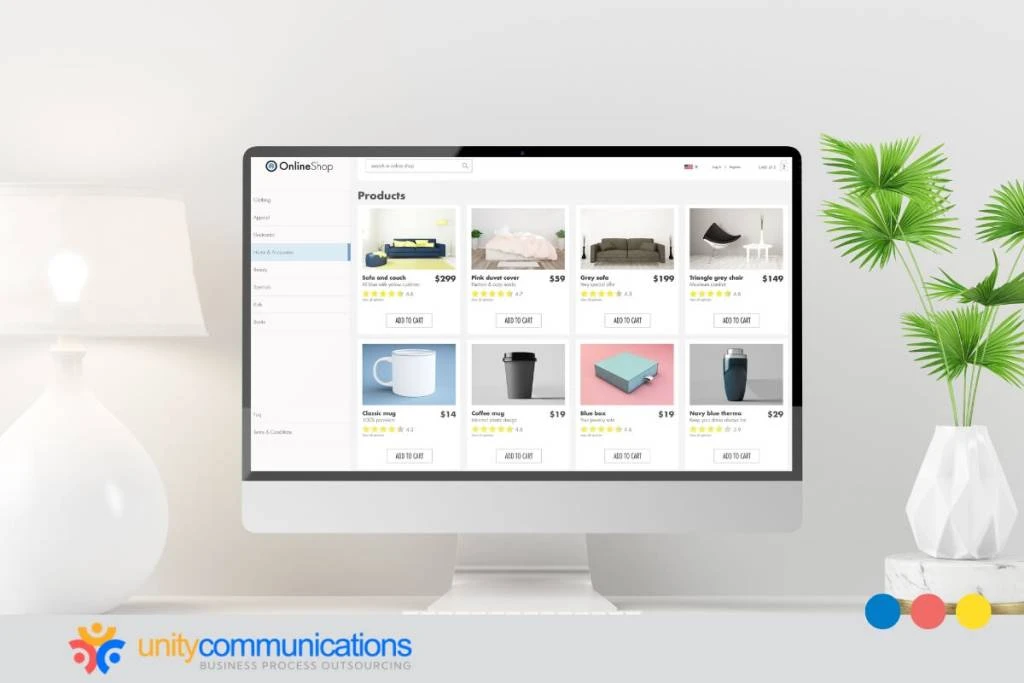Table of Contents
Call centers for e-commerce offer many services, from exceptional customer support to persuasive content creation. Providers also deliver effective product listings, a crucial aspect of e-commerce operations.
This process requires specialized expertise, sophisticated technologies, and scalable workflows. Partnering with an outsourcing company provides online retailers with all these resources and features without compromising their financial health.
This article discusses the benefits of e-commerce product listings and how outsourcing can streamline the process. It also addresses common misconceptions about outsourcing and shares tips for successful integration.
What Are E-commerce Product Listings?

Let us first discuss what e-commerce product listings are to better understand the advantages of outsourcing them. A product listing is a digital shelf meant to showcase the products offered by online shops. Its primary purpose is to give customers the details they need to make an informed buying decision.
Typically, e-commerce product listings include the following:
- High-quality product image(s). A photo is the best way to catch a shopper’s attention. However, showcasing images may not be enough. Ensuring product pictures are clear, attractive, and representative of the product’s uses, dimensions, and quality is critical to converting buyers.
- Product name and description. Concise and informative, these two aspects of a listing highlight a product’s key features and benefits. When creating names and descriptions, follow search engine optimization (SEO) best practices and include keywords that customers might use.
- Price. Customers expect to see how much a product costs upfront. Hidden prices can frustrate customers and make them perceive the shop as deceptive. Display the price prominently and clearly. Include applicable taxes and fees to reduce friction or barriers to purchase.
- Call to action (CTA). This aspect of a listing serves as a nudge in the right direction. A CTA guides consumers toward the next step, whether adding the item to their cart, buying immediately, or learning more about the product. Adding a sense of urgency to a CTA can also be a good strategy for conversion. The CTA can be in the product listing’s copy or a website button.
- Additional details. Depending on the product, additional information can be advantageous. Online shoppers cannot physically examine items through e-commerce platforms. Adding product details, such as size, color, material, warranty, shipping data, and customer reviews, fills this information gap and builds trust and confidence.
Maximizing E-commerce Product Listings With Outsourcing

Business process outsourcing (BPO) can help your e-commerce shop streamline product listing processes while reducing costs. It allows you to access additional expertise, leverage sophisticated technologies, and increase scalability.
But what is BPO? It is the practice of delegating non-core tasks to a third-party provider. Its many benefits make it widespread across all business sizes and industries.
Grand View Research reports that the global BPO market value reached around $261.9 billion in 2022. Their data predicts the sector will expand at a compound annual growth rate (CAGR) of 9.4% by 2030.
Product listing is part of what e-commerce customer service covers. Specialized BPO providers employ third-party professionals to ensure efficient and effective listings while improving overall support operations for e-commerce businesses.
Outsourcing is best for and typical among businesses new to online selling and small shops looking to save on resources. The following section delves further into its benefits.
Access to Additional Expertise
Partnering with a BPO provider lets you tap into a global talent pool of professionals familiar with e-commerce trends and best practices. They can adapt to their client’s branding and master product and service information quickly.
These third-party professionals are also proficient in various tasks related to product listing, including:
- Creating new listings. Developing a catalog from scratch is tedious. Your e-commerce shop can delegate this product listing task to outsourcing teams. They will gather, organize, and analyze product information and create clear, concise, and informative descriptions. They can also take, edit, and upload high-quality product images.
- Updating existing listings. Maintaining data accuracy is critical in any product listing. Outsourcing teams regularly update listings to ensure the products’ pricing, availability, shipping information, and other details align with current statuses. They also update listings with new keywords for better search engine visibility.
- Responding to customer inquiries. Working with BPO providers means partnering with customer support experts. You can rely on them for inbound call center services for e-commerce. They can answer questions about product features, specifications, pricing, and updates.
- Monitoring and managing product reviews. You can also assign call center BPO teams to respond to positive and negative customer reviews. These interactions offer insight into customer sentiment, product performance, and areas of improvement. Workers can also flag and report comments that violate the terms of service.
- Providing technical support and maintenance. E-commerce product listing outsourcing teams can help create and maintain accounts on various platforms and marketplaces. They are also skilled in resolving technical problems with your listings and analyzing data on clicks, conversions, and other metrics.
BPO teams are also proficient in navigating the different regulations surrounding e-commerce listings. These include product safety and labeling codes, pricing and advertising, consumer protection, and dispute resolution. They are also trained in data privacy, security, and intellectual property laws.
Leverage of Sophisticated Technologies
Outsourcing is known for its ability to provide businesses with the latest tools and software, both task-specific and general. Partnering with a provider with the necessary technology allows you to streamline processes, reduce the risk of human errors, and enhance performance.
Here are some of the technologies BPO teams use:
- Product information management (PIM) systems. These platforms centralize, manage, and enrich product information in all applicable sales channels. They are a single source of truth for all product data, ensuring consistency and accuracy across your website, e-commerce platforms, and marketing materials.
- Data entry automation tools. Manually inputting and double-checking listing information is repetitive and time-consuming, making it prone to delays, fatigue, and typos. Data entry automation tools boost efficiency and ensure consistent formatting. It saves BPO teams time and effort while improving accuracy.
- Keyword research tools. E-commerce shops can leverage impactful keywords for product listings with the help of outsourcing teams, who often use keyword research tools. These platforms provide insight into search volumes, user intent, and competition. Analyzing this data helps find keywords that drive the most traffic and conversions.
- SEO analysis tools. Assessing your product listing’s SEO health and performance is impossible without these tools. They help you identify areas of improvement, such as broken links, slow loading times, unresponsive mobile designs, and erroneous indexing. SEO analysis tools track your progress toward higher search engine rankings.
- Listing optimization tools. These platforms assess your existing keyword usage, identify expansion opportunities, and suggest relevant, high-performing keywords to target. They also analyze your listing descriptions, titles, and content for clarity, readability, and SEO best practices. Listing optimization tools also evaluate images.
- E-commerce platform analytics tools. Insights into impressions, clicks, conversion rates, traffic sources, customer demographics, and behaviors are essential. E-commerce platform analytics tools provide accurate information on such matters, allowing you to improve your listings and online sales strategies.
- Customer relationship management (CRM) systems. Although they may not directly impact product listing processes, CRM tools are crucial to the e-commerce ecosystem. They gather customer feedback, identify trends and buying behaviors, and segment shoppers. They also personalize product content, allowing for a successful initiative.
Other technologies outsourcing providers leverage include artificial intelligence (AI) and cloud computing. They significantly support outsourcing teams in streamlining any task.
A study submitted to the National Bureau of Economic Research points out that generative AI improves productivity by an average of 14%. Meanwhile, a survey by Deloitte shows that cloud computing helped small to medium-sized businesses (SMBs) increase profit by 21%.
Scalable and Personalized Support
E-commerce businesses tap their product listing outsourcing partner for additional expertise and technologies, which they can scale as needed. BPO teams are readily available for hire without long-term commitments and additional costs.
Third-party automation tools also accelerate time-consuming routine tasks, allowing businesses to handle surging volumes without hiring more staff. This flexibility and on-demand scalability support your online business in adapting to demand fluctuations and resource underutilization.
In addition, outsourcing enables the following features:
- Multilingual services. Outsourcing product listings to an area that speaks different languages, such as Mexico and the Philippines, allows you to cater to global markets. BPO providers also actively hire and train call center agents fluent in various tongues and utilize multiple language tools and software for translating product listings.
- Round-the-clock operations. Partnering with a BPO firm with operations in various time zones provides you with a 24/7 team. They can operate your e-commerce shop beyond regular business hours, addressing product concerns and inquiries around the clock. This feature ensures lower downtimes, giving your shop a competitive advantage.
- Global market insight access. Outsourcing providers often have fixed partnerships or subsidiaries in different international locations. This access allows them to tap into on-the-ground expertise, cultural understanding, and local market knowledge. Understanding global search trends and keywords offers better product listing visibility.
Cost Reductions and Savings
Your e-commerce enterprise can cut expenses in many ways through product listing outsourcing. Several factors contribute to the practice’s cost-saving potential, including:
- Lower labor costs. Wages often vary significantly between countries, with some areas offering lower labor costs than others. Outsourcing to regions with lower living expenses and compensation costs can help you save on salaries. For example, businesses that outsource to the Philippines report cutting labor costs by 70%–90%.
- Shared resources. BPO providers leverage infrastructure and resources, allowing them to offer economies of scale to their clients. This feature lowers costs for various operating necessities, such as data storage, communication networks, and technological advancements. You no longer have to worry about costly investments.
- Reduced overhead. Since most BPO initiatives involve working with a virtual team, they can accomplish delegated tasks remotely. Thus, they help your e-commerce shop avoid the costs of maintaining and expanding office space. Outsourcing also lets you minimize expenses on equipment, utilities, and other physical necessities of operating in-house.
Why Should E-commerce Shops Outsource Product Listing Processes?

Product listings are the cornerstone of any e-commerce business. They ensure businesses can effectively showcase their products, engage users and convert them into buyers, and ultimately drive sales. The many features and services of outsourcing further boost product listing success.
Here are other reasons you should consider outsourcing product listings:
1. Keeping Pace With the E-commerce Industry
Maximizing the advantages of e-commerce product listing might be more challenging with an in-house team than outsourcing. Certain constraints could hinder you from topping search engine results and reaching the right audience. Here are a few factors that might make this function difficult to accomplish internally:
- Labor market. SEO tasks require specialized talent who is versed in specific platform requirements. Such expertise may be difficult and expensive to find domestically, especially as the global labor market remained relatively tight throughout 2023.
- Technology limitations. Keeping up with the latest platform changes and new technologies is more challenging when you are limited to in-house resources. Digital transformation is among the leading BPO trends and predictions. Thus, most providers offer technological advancements and the tools to streamline product listings.
- Lack of objectivity. Internal teams might be biased toward products or promotions based on sales targets, profit margins, or personal reasons. Identifying with a particular item could also cloud judgment. Outsourcing prevents this drawback since external teams do not experience the same emotional attachment or pressure.
2. Boosting Employee Engagement and Productivity
Creating high-quality listings for an inventory of any size takes significant time and effort, and staff constraints cause issues in accomplishing this task. The repetitive nature of e-commerce product listings could decrease passion and creativity, resulting in monotonous content.
E-commerce product listing outsourcing provides a helping hand, accomplishing tasks quicker without compromising quality.
With less work, your internal team will feel less stressed and pressured, especially if product listing is outside their expertise. They can use their skills and talents more effectively, reducing the risk of fatigue that often leads to:
- Burnout
- Employee turnover
- Errors and delays
- Low-quality outputs
Thus, outsourcing increases employee satisfaction and motivation, providing a more positive and productive office environment. It also minimizes turnover rates, which could tarnish your brand’s image.
3. Improving Overall Shop Performance and Quality
All the features of outsourcing prove that it can assist your online store in streamlining product listings and other operations. Aside from the benefits mentioned above, partnering with a BPO provider also helps you with:
- Consistency and accuracy. Maintaining uniformity in product information, formatting, and tone across numerous listings can be difficult. This situation is more likely to occur when multiple contributors are on the team. Inconsistencies and mistakes in even the smallest details, prices, and inventory levels could damage your brand.
- Creative competition. The online shopping landscape is constantly growing, set off by the pandemic. The first step to standing out in the e-commerce market is having unique and compelling product listings. Outsourced and affordable call center services employ creative minds worldwide, bringing new perspectives and strategies to your business.
- Focus on core competencies. You can reallocate the resources you saved through outsourcing, whether finances, staff, or technologies, to more critical business matters. These activities could be product development, market research, or market expansion. They can be anything that impacts your shop’s growth, brand visibility, and profitability.
Debunking Myths About E-commerce Product Listing Outsourcing
Many enterprises still have reservations about outsourcing despite its benefits. As with any business decision, this strategy has its fair share of misconceptions. Let us discuss and dispel some common myths surrounding the practice.
- Outsourcing means losing control. Outsourcing fosters collaboration and not abdication, especially when done right. Choosing a partner that shares your brand values and considers your target market makes integration easier. The next section discusses successfully integrating outsourcing into your business model and processes.
- Outsourcing is all about saving money. While outsourcing offers cost savings, it is still a significant investment. You should partner with a provider specializing in e-commerce and product listing with a proven outsourcing track record, even if it means spending more. Opting for a cheaper option could cost you more in the long run.
- Outsourcing hurts creativity. Fresh perspectives can spark greater creativity. Outsourcing brings new ideas and approaches, potentially leading to more captivating and compelling product listings than your in-house team could produce alone. Creating synergy between third-party and internal staff is the key to developing quality content.
- Security is a significant risk when outsourcing. Outsourcing providers prioritize data security and implement robust measures to protect confidential information. They often share responsibility, as outlined in the service-level agreement (SLA). A partner with robust security protocols and compliance certifications mitigates risks.
- Language barriers brought by outsourcing create conflicts. Many BPO teams are skilled in multiple languages and cultural nuances. They are trained to understand and adapt to their client’s speaking methods, with some even learning various accents. You can avoid misunderstandings by establishing transparent communication systems.
- Only large firms benefit from outsourcing. E-commerce product listing outsourcing is valuable to solopreneurs, SMBs, and corporate giants. Its ability to provide specialized expertise, technology, scalability, and efficiency at lower costs makes it a practical choice for enterprises with fewer resources.
How to Delegate E-commerce Product Listing to Outsourcing Teams

Seamlessly delegating your product listing tasks to a BPO provider requires a clear roadmap and thorough preparation. The entire transition process can be broken down into three steps. Below is a comprehensive guide to help you navigate the start of your outsourcing initiative.
1. Communication and Collaboration
When you have chosen the best call center for your e-commerce shop, schedule a kickoff meeting with its team. During this meeting, outline your expectations, timelines, deliverables, quality control processes, and communication protocols. This information should also be included in your SLA.
Provide the third-party team with the necessary resources for onboarding, such as:
- Brand guidelines
- Competitor analysis
- Target market insights
- Product information databases
2. Launch and Monitoring
A phased rollout is typical in outsourcing. Start with a smaller set of product listings to test the waters and refine the process before fully delegating your entire catalog. Track key performance metrics (KPIs) to assess your BPO team’s effectiveness. Some examples of KPIs include:
- Conversion rates
- Click-through rates (CTRs)
- Bounce rates
- Organic traffic
This second part of the transition process is critical for the long-term success of your outsourcing initiative. Regularly analyzing data and KPIs identifies weaknesses and strengths in your systems and strategies. Stay updated on platform algorithms and adjust your approach accordingly.
3. Streamlining Workflows
Utilize project management software to assign tasks, track progress, share files, and facilitate communication effectively. Popular options include:
- Trello
- Asana
- Monday.com
- JIRA
- Nifty
During the first few months of your initiative, consider assigning an internal team member to perform a final review of product listings before publishing. Additionally, encourage an open feedback loop where both sides can share insights and suggestions for improvement.
Your e-commerce business should be open to adapting your initial product listing plan based on data and ongoing outsourcing analysis.
The Bottom Line
Outsourcing product listings is advantageous for scaling e-commerce businesses. It allows online retailers to enjoy the benefits of effective catalogs at a fraction of the cost of operating in-house.
Although many misconceptions plague the practice, it is still a popular strategy across several industries. Taking the necessary steps to integrate outsourcing into your business model easily assuages any concerns.
Let’s connect if you want to learn more about e-commerce outsourcing for product listings!



